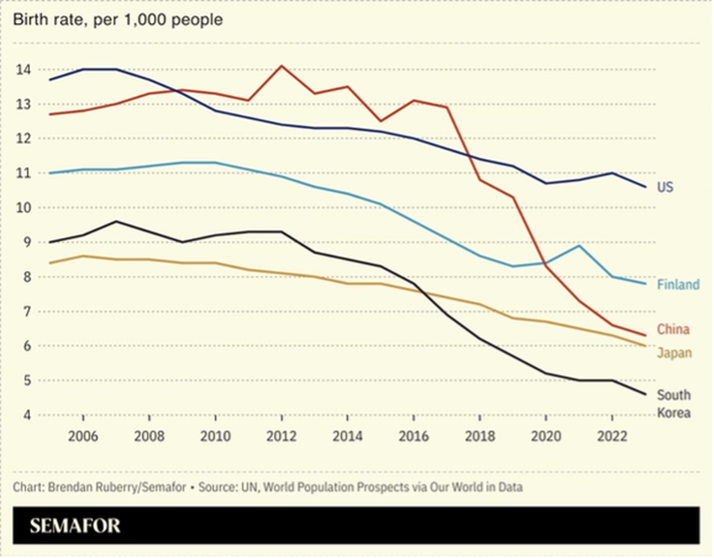Most hiring tools answer whether candidates can and will do the job, but not if they’ll stay. Learn how realistic job previews and motivational-fit interviews can improve retention from day one.
Today’s Riddle – What is America’s Greatest Business Challenge?

Last week I talked about the tremendous decline in the number of 18-year-old Americans, such that colleges are closing at a time when 43% of our jobs will require college degrees by 2031. And this is happening while the US has fallen to 9th among developed nations in the proportion of its population having at least some post-high school education.
—–
Further reading: Fewer Students, Fewer Workers, and a Hiring Crisis Ahead – Are You Ready?
—–
Declining Birthrates are a Real Problem – and We Aren’t Alone
The culprit here is our continuously declining birth rates which reached their height after WWII and then saw steady decline, culminating in our being below the 2.1-births-per-woman replacement rate for nearly every year since 1972.
America’s position then as the world’s economic leader is clearly at threat, as we cannot fill our most important jobs now and this will only get worse. But for whatever the true causes are, this let’s-not-have-a-baby syndrome has reached into nearly every industrialized nation as well. The chart below shows the decline for just some of those countries:

So the riddle is how will each first-world country win the declining birth rate skirmish, such that their economy will thrive when many economies appear to be in great peril?
Country-specific data is astounding. The German working population will reduce by a third by the end of this century, along with Italy, Spain, and Greece losing half of their total workforces, and then Poland, Portugal, Romania, Japan, and China will all lose up to two-thirds of their labor force.[i] Another report details that by 2030, that soon, the world will be short by 85 million workers, the approximate population of Germany. Six million of these shortages will be here in the United States.[ii]
Sampling national responses, Germany has legislated an immigration skill-based point system,[iii] South Korea is considering paying a $70,000 bonus for each newborn child,[iv] and Japan has rejected immigration as a fix and is instead implementing “womenomics”, asking more of their women to join their workforce.[v]
Russia’s baby-shortage solution is quite different, where one region’s minister of health instructed that having a busy career wasn’t an excuse for not having a family, and that people could choose to “create offspring” during work breaks.[vi] There was no mention of wine or candles.
South Korea’s birthrate has fallen to the world’s lowest, resulting in sales of dog strollers outselling sales of baby strollers. Their president has declared this to be a national emergency, all while he and his wife have no children but ten cats and dogs.[vii]
—–
Further reading: Colbert, “Work Breaks” and Birthrates
—–
The Birthrate Contrast is Striking
Recalling that each woman must give birth to 2.1 children for any population to sustain at the same population level, the birthrate difference between first-world and third-world nations is severe. As just one example, the World Bank tells us the recent birthrate for the US is 1.6 whereas the birthrate for Sub-Saharan Africa is 4.5.
So where does “running out of people to maintain national economies” rank among other challenges? The countries that win here will dominate not just in business but in other ways, too, as they will develop money and know-how to lead the world. That’s American’s job, right?
One obvious outcome is that retaining your best workers has never been more important. And next week I’ll dig even deeper for how the winning nations who maintain the winning economies will actually win.
What would you do if your new job was to solve this problem for America?
Employee Retention for Organizational Success
Now is the time to plan how you will retain your best workers now to mitigate the numbers you will need to hire in the future. If you know you need to address turnover or improve engagement but aren’t sure where to start, email me at DFinnegan@C-SuiteAnalytics.com and I promise to help you jump start your employee retention strategy now, so you can see results this year.
[i] Sebastian Dettmers, “The Great People Shortage is coming — and it’s going to cause global economic chaos,” Business Insider, October 20, 2022; https://www.businessinsider.com/great-labor-shortage-looming-population-decline-disaster-global-economy-2022-10#:~:text=In%20the%20coming%20years%2C%20many,these%20businesses%20will%20also%20shrink
[ii] Ivana Johnston, “Turning Silver Into Gold: Are Unretired Workers A Solution To The $8.5 Trillion Labor Shortage?”, Forbes, March 25, 2024; https://www.forbes.com/councils/forbesagencycouncil/2024/03/25/turning-silver-into-gold-are-unretired-workers-a-solution-to-the-85-trillion-labor-shortage/#:~:text=According%20to%20predictions%2C%20by%202030,first%20time%20in%20U.S.%20history.
[iii] “Working in Germany with the Opportunity Card”, Chancenkarte Deutschland; https://chancenkarte.com/en/candidates/#:~:text=To%20receive%20the%20Opportunity%20Card%20through%20the%20points%20system%2C%20basic,B2%20is%20awarded%203%20points.
[iv] Tyler Cowen, “Could a $70,000 Baby Bonus Solve South Korea’s Fertility Crisis?”, Bloomberg, May 14, 2024; https://www.bloomberg.com/opinion/articles/2024-05-15/south-korea-fertility-crisis-could-public-subsidies-solve-it?utm_content=view&cmpid%3D=socialflow-twitter-view&utm_medium=social&utm_source=twitter&utm_campaign=socialflow-organic&sref=htOHjx5Y&embedded-checkout=true
[v] “Womenomics” in Japan, Asia Pacific Curriculum; https://asiapacificcurriculum.ca/learning-module/womenomics-japan
[vi] Briar Stewart, “Russia wants a baby boom, but some women resist becoming a mother for the motherland”, CBC News, September 20, 2024; https://www.cbc.ca/news/world/russia-mothers-birth-rate-1.7327712
[vii] Dasl Yoon, “Nation With Lowest Birthrate Is Rocked by Soaring Sales of Dog Strollers,” The Wall Street Journal, September 8, 2024; https://www.wsj.com/world/asia/nation-low-birthrate-childlessness-dog-strollers-south-korea-e9778517



